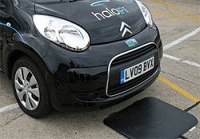The technology, developed by HaloIPT, will be trialled for around a year, during which time specially adapted cars and vans will be able to charge by simply parking over the pads.
Isabel Dedring, the mayor of London’s environment adviser, said: ‘From a practical point of view, it would make charging much easier and we hope to play our part by testing it on four of our vehicles. If we can prove it works in an operational environment, then we will be another step closer to the electric revolution that the mayor wants to see in the capital.’

It follows an announcement earlier in the month that TfL is installing 1,300 plug-in charge points around the capital in collaboration with Siemens — suggesting competing technologies are being considered for the so-called ‘electric revolution’.
Nevertheless, Dedring warns that inductive charging is still some way from hitting the streets of London for use by regular consumers.
If the trial proves successful, HaloIPT hopes to roll out inductive charging on a larger scale, and company chief executive officer Dr Anthony Thomson said there might be niche markets to exploit in the short-to-medium term.
‘We’re very keen on taxis. It’s difficult for drivers to be jumping out and plugging in… When you look at Paddington and Waterloo stations, they spend a lot of time cruising along the taxi rank for hundreds of metres and they could be picking up a charge all the way along,’ said Thomson.
There are, however, some challenges remaining, not least of all cost. Retrofitting existing electric vehicles with the capability for inductive charging costs around £3,000, while the charging pads themselves cost around £2,500. Meanwhile, opponents say there are issues with charging efficiency, safety and electromagnetic compatibility (EMC).
‘There has been a lot of mythology around wireless charging being inefficient. Although we lose a couple of per cent from the road to the car, most high-frequency plug-in chargers have a similar loss through AC-DC conversion and back again,’ added Thomson.
HaloIPT has been conducting independent tests with the Sustainable Vehicle Engineering Centre at Oxford Brookes University that directly compare inductive versus plug-in technologies. Early data apparently show they are more or less equal in terms of charge efficiency, with inductive possibly showing a marginal benefit.
Vehicle engineering and testing business MIRA is currently investing heavily in low-carbon vehicles and says that, while it is focused on plug-in, inductive could be a possibility in the future.
‘I see great potential for inductive, but real challenges around EMC. Basically, if you’re trying to transmit energy in that format, what impact might that have on other sensitive electronic systems in the vehicle or handheld smartphones?’ said Dr George Gillespie, chief executive officer at MIRA.
HaloIPT counters this, saying that EMC has been a key consideration right from the early stages of development, and there are various sealing systems to ensure it does not create interference.
Even if inductive charging is shown to be the superior technology in independent tests such as the one at Oxford Brookes, it may have an uphill battle in terms of adoption by municipalities and automotive manufacturers, given that plug-in has had something of a head start.
‘Plug-in is here and now. If you look at the lifecycle on products, we’re not going to have a broad range of inductively charged electric vehicles on the market for at least five years, yet we’ve got a growing fleet of electric vehicles that will require charging,’ said Gillespie.





Swiss geoengineering start-up targets methane removal
No mention whatsoever about the effect of increased methane levels/iron chloride in the ocean on the pH and chemical properties of the ocean - are we...